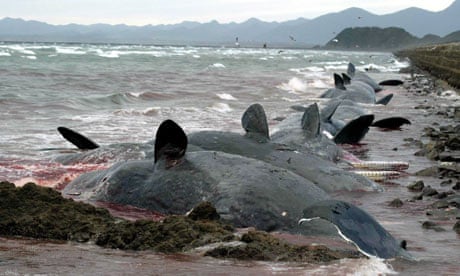There are many theories as to why whales beach themselves, blaming seismic activity, electro-magnetic anomolies – and us

Of all cetaceans – whales and dolphins – pilot whales are the species most likely to strand themselves. Indeed, their name itself, pilot whale, comes from their propensity to follow a single ‘leader’. This may be one reason for the strange behaviour of about 100 pilot whales that are currently circling off Loch Carnan in South Uist.
An ailing whale will often head for the shore – possibly because it can no longer support itself in the water (and might therefore drown). Whales are particularly loyal in their social organisation, and, likewise, an entire pod may follow a sick comrade and beach themselves. This behaviour has even been observed in sperm whales (toothed whales, like pilots) which, although they are the largest known predator, will also beach themselves, sometimes in great number.
Another possible explanation for this behaviour is bad weather. Since the Natural History Museum began recording strandings around the British coast line in 1913, some correspondences have been drawn between storm conditions at sea and whale strandings. There are particular ‘hot spots’ for pilot whale strandings around the world: such as the Scottish west coast, as in today’s incident, New Zealand and Cape Cod.
One theory is that, since whales are migratory animals which, like birds, use electro-magnetic lines laid down in the earth’s crust in order to navigate, they may be deceived by local anomalies in the terrain. For instance, Wellfleet in Cape Cod, an infamous and regular stranding site, is largely a recent geological feature – in essence, a sand bar – that may cut across old electro-magnetic pathways.
Another idea is that seismic activity in the earth’s surface can cause strandings – which could in turn be a forewarning of an earthquake. Forty-eight hours before the Christchurch earthquake in February this year, more than 100 pilot whales died on Stewart Island, off the southern tip of New Zealand’s south island, having been stranded there two days beforehand. Barely a week later, on 4 March, fifty melon-headed whales washed up on the eastern Kashima shore of Japan prior to the disastrous Japanese earthquake.

But the most controversial theory, one that recent investigations appear to prove, is that anthropogenic, or human-generated noise, may be to blame. For whales, the sense of sound is above all their most important way of reading the underwater world. They navigate, communicate, and hunt by sound. The modern use of military sonar, which unleashes incredibly loud sound into their environment with no preliminary warning, has been shown to cause deep-diving whales, such as pilot whales and beaked whales (the family to which the famous Thames whale belonged), to surface too quickly. In effect, they panic. Seismic surveys for oil exploration – particularly in the North Sea and around Scotland – may have the same effect.
As a result, the animals suffer the same syndrome as human divers who resurface too quickly: decompression sickness, or ‘the bends’. Necropsies of pilot whales have revealed them to have suffered tell-tale burst blood vessels.
Most important in this sad but sadly not uncommon incident will be the analysis of any carcasses by the Zoological Society of London. Its findings, together with work being done by the Natural History Museum – which has a dedicated Cetacean Strandings Investigation Programme – will help us understand why these beautiful animals should appear to ‘commit suicide’ in such a stark and heart-rending manner.
Philip Hoare, author of Leviathan or, The Whale, is currently Leverhulme artist-in-residence at the Marine Institute, University of Plymouth










